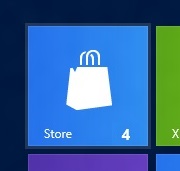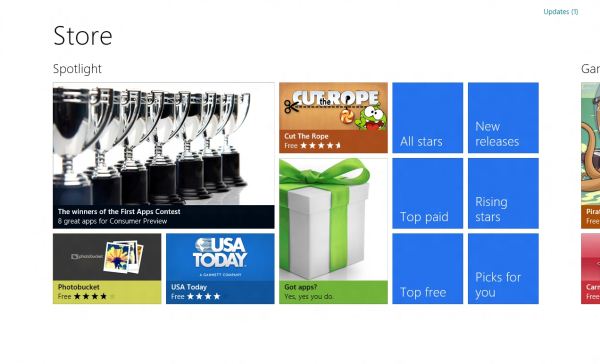In-Depth with the Windows 8 Consumer Preview
by Andrew Cunningham, Ryan Smith, Kristian Vättö & Jarred Walton on March 9, 2012 10:30 AM EST- Posted in
- Microsoft
- Operating Systems
- Windows
- Windows 8
Now that we’ve covered the bulk of Windows’ new UI elements, it’s time to get down to some individual apps, and there’s no app more important to Windows 8’s success than the Windows Store.
Unfortunately, at this point it's a bit difficult to tell how the store is going to work out—it seems like one of the less-finished apps provided in the Consumer Preview. There are basic categories for games, social apps, music apps, and a few others, but aside from the basic Search functionality (which is accessed from the Charms menu), there's just a sprawling "top free" list and a lot of scrolling. The Windows Store definitely shouldn't be judged on this early iteration, but a lack of polish (unlike in other Metro screens, more tiles don't show up when more screen space is available—if you look at the Store on a screen with a vertical resolution of much more than 768 pixels, you'll just see a big unused area of white space below the Store tiles) and missing features make it a rough demo at best.
As in both the Apple and Android app stores, you’ll need to sign in with a Windows Live ID to download anything from the Windows Store. If you used your Windows Live ID to create an account during Windows Setup, the OS can download and install apps without asking you for any extra information, but you can still use your Live ID even if you chose to create a local account. Once you’ve purchased an app, you’ll be able to download that app to any Windows 8 or Windows on ARM device you’ve signed into with your Windows Live ID.

All of the preview apps in the Windows Store are currently offered free of charge, but in the RTM version of the store developers will be able to offer both “Buy” and “Try” buttons for apps with demos—apps can have either timed or feature-limited demos available. Unlocking the full version of the app requires no separate download, and all of your saved data from the demo is still available. Info pages for apps also list compatible processor architectures—x86, x64, and ARM.

As seen above, when updates are available a small number will appear on the Windows Store tile. Entering the Store and clicking the "Updates" link in the upper right-hand corner of the screen will present a list of available updates, which you can install individually or all at once.
Apps submitted to the Windows Store have to make it through Microsoft’s approval process, which looks to be a more developer-friendly version of Apple's system: Windows 8 will be a curated platform, which should help curb some of the malware problems that Android is having. However, criteria for approval are clearly laid out, and developers whose apps are rejected will be given feedback on what changes they'll need to make to get approved. Microsoft is also updating its development tools to help guide developers through all the steps of the certification process.
For both advertisements and in-app purchases, Microsoft offers its own platforms but does not mandate their use. If a newspaper or magazine publisher has an existing database of its users and a pre-existing authentication system, that publisher is free to continue using them in its app. Apple began mandating the use of its systems for in-app purchases last year, meaning that all in-app purchases on iOS are subject to Apple’s 70/30 revenue split, and Google may be moving to prohibit third-party in-app purchases even as you read this.
Lastly, let’s assuage the fears of enterprise administrators: via group policies and PowerShell scripts, domain administrators can both permit and deny access to the Windows Store and to individual apps, and can also deploy Metro apps directly to PCs without using the Windows Store at all. This opens the door to volume-licensed apps, and will help IT admins to provide a consistent set of programs and features across different Windows 8 systems.
Whether the Windows Store will succeed remains to be seen—things like app discovery and user interface are important, but in the end the Windows Store is just a portal that will live or die on the quality and quantity of its apps. Those that are available are in a preview state, and while we’ll look at a few of the core Metro apps later on in this article, it doesn’t make a lot of sense to to do in-depth reviews of apps that are in beta-at-best states.
I will lay out one major concern up-front: while apps like Evernote and Cut the Rope do well on smartphones and tablets, I wonder how well more full-featured programs like Photoshop and Office will scale to Metro with their functionality intact. The Windows Store and its WinRT APIs are Microsoft’s future, but take this as a case in point: Microsoft is going to be shipping a copy of Office with every Windows on ARM tablet, but rather than providing Metro versions of Word, Office, PowerPoint, and OneNote to show developers how it’s done, it’s providing copies of those programs that will run only in the desktop environment, and it’s doing this in spite of the fact that no other developers will be able to use the Windows desktop on Windows-powered ARM tablets.
That doesn’t necessarily mean that Office apps will never get Metro styling, and it doesn’t mean that developers aren’t going to make some nice, feature-rich Metro apps, but Microsoft’s refusal to eat its own dog food in this case makes me a little nervous about the kind of programs we’ll end up seeing in Metro.











286 Comments
View All Comments
Klimax - Sunday, March 11, 2012 - link
One person data doesn't make...(Point is,you are very incorrect. It's not even close to 50% and that's counting only those vocal about it)
tviceman - Friday, March 9, 2012 - link
How will windows 8 work with programs like Steam? I always have steam running, and I chat through steam almost as often as I game from it. From how it sounds, I'll have to switch over to desktop view to access steam? And if someone sends me a message and I'm in metro, will I be notified?Andrew.a.cunningham - Friday, March 9, 2012 - link
Depends on whether desktop apps can make use of the notifications in Windows 8 - I'm honestly not sure about that right now, since so few desktop apps are Windows 8-aware. How do you tell when Steam sends you messages in Windows 7 - do you rely on sound cues? Flashing taskbar icons? There are lots of potential answers to the question but a lot of it depends on (1) how Valve can/does change Steam for Windows 8, and (2) your particular usage patterns.beginner99 - Friday, March 9, 2012 - link
...crap for little children. I guess I will have ti buy a spare copy of win 7 as long as they are available for my next build...UI looks made for 6 year old kids, liek a toy-computer. Omg...if only games could run on linux.
dchinu - Friday, March 9, 2012 - link
Exactly my thought only for gamekmmatney - Friday, March 9, 2012 - link
I think WIndows 7 will be available for a long time yet... I do like the storage spaces, and as a WHS ver 1 user, this looks like a nice upgrade to drive extender. Hopefully the next release of WHS will have this built-in.chromeshield - Friday, March 9, 2012 - link
Seriously disappointed .. not even one AMD system tested, here 50 people can talk whatever they want., who uses AMD and all I wont even bother to reply to them.Anand .. .. am not some idiot bystander, but very well positioned and educated person writing this... wake up....
I expected some APU's, VIA, and few graphics combinations tested,
I had heard a lot that this website is Intel biased but never believed anybody.. but today I had to bother to create an account... to write this comment..
disappointed.
Andrew.a.cunningham - Friday, March 9, 2012 - link
Dude. DUDE. SO MANY THINGS.1) Anand doesn't write every article on the site. Check the byline.
2) If you want to subsidize some AMD-based equipment for me, please do so - I can take checks or PayPal. As a contractor the vast majority of the hardware I have to test with is my own, and I've gone out-of-pocket for it.
3) Is running Windows 8 on AMD hardware going to change my opinions about how Metro works? About the raw CPU and GPU horsepower required to run Windows 7? About the new or changed features? If I hadn't published specs for systems I tested Windows 8 on, would it make my opinions more valid, or would you be complaining about the lack of information? What if I had lied and made up some AMD systems without actually doing any testing on them?
The point of Windows is that it runs THE SAME WAY on ALL x86-compatible CPUs, on ALL GPUs with proper drivers and support for its graphics APIs.
In closing, congratulations for getting a few hundred words into this massive article, not seeing the letters AMD in a single table meant to provide context and additional information to you, the reader, and proceeding to completely miss the point.
Andrew.a.cunningham - Friday, March 9, 2012 - link
Windows 7 = Windows 8 in point 3, just in case you wanted to miss the point in favor of focusing on a perceived mistake again. /rantMalih - Friday, March 9, 2012 - link
probably most wonder whether the W8CP in it's current state would run stable on AMD hardware, including me.